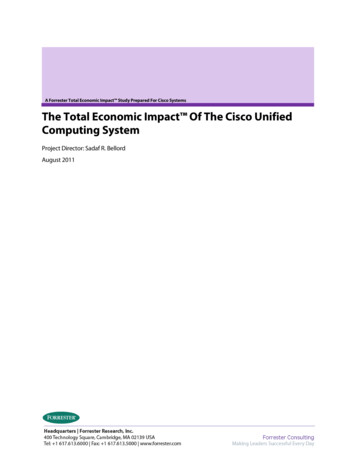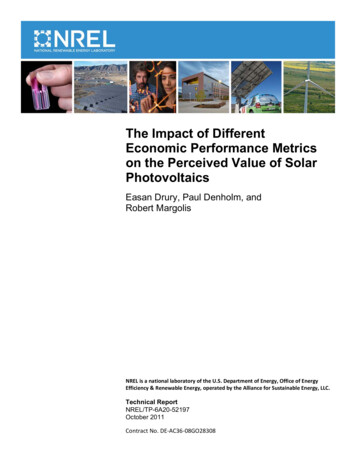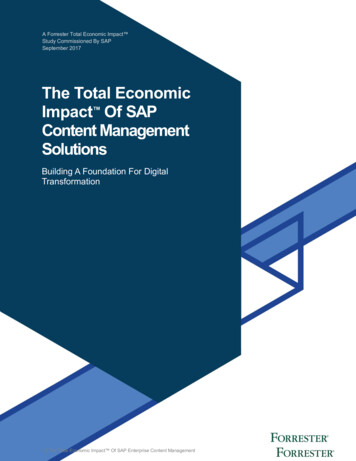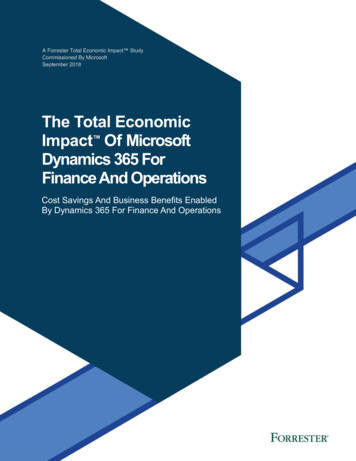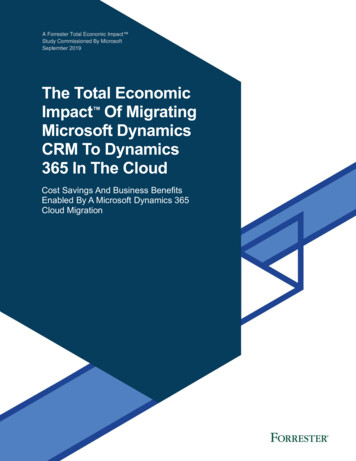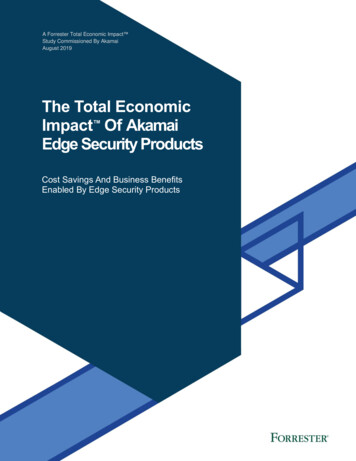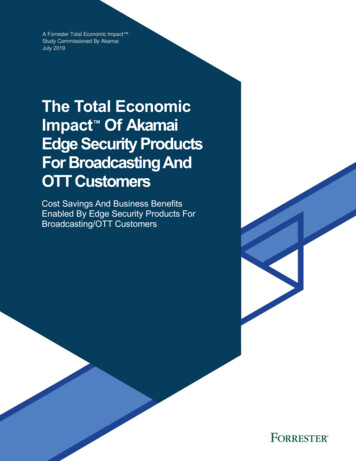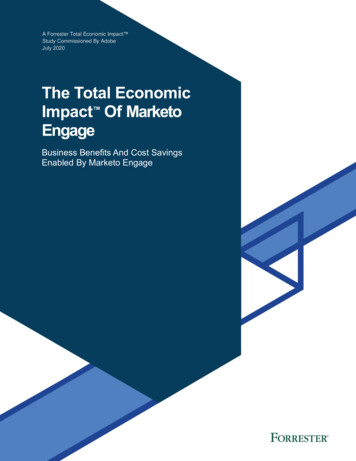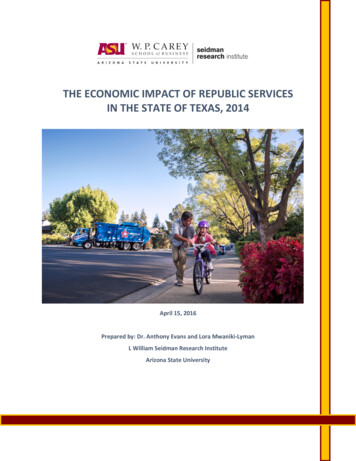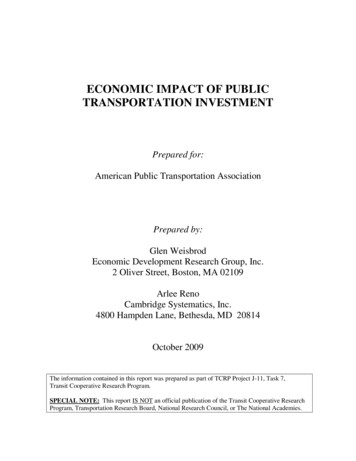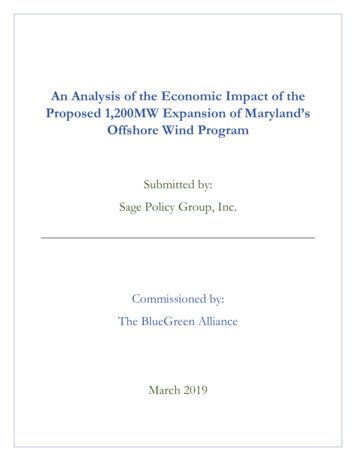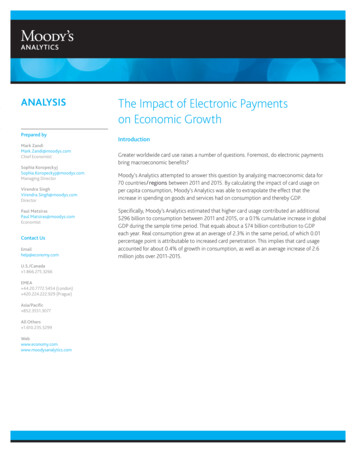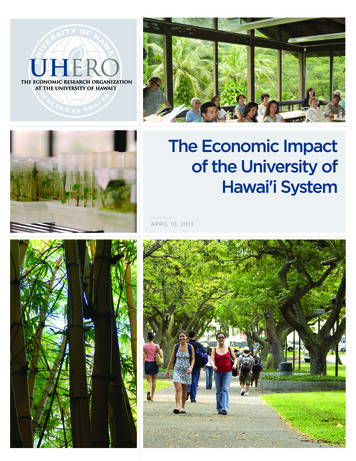
Transcription
The Economic Impactof the University ofHawai'i SystemAPRIL 10, 2013
The Economic Impact of theUniversity of Hawai'i SystemAPRIL 10, 2013Prepared by:University of Hawai‘i Economic Research Organization(UHERO)UHERO Principal Investigators: Inna Cintina (Assistant Specialist), Kimberly Burnett (AssociateSpecialist), and Carl Bonham (UHERO Executive Director and Professor of Economics)Research Assistance By: Christopher Wada (Post-Doctoral Researcher), James Jones (EconomicResearch Specialist), Atsushi Shibata (Graduate Research Assistant), Ben Trevino (Database Manager), and Natalie Schack (Graphic Design Support)UNIVERSITY OF HAWAI‘I ECONOMIC RESEARCH ORGANIZATION2424 MAILE WAY, ROOM 542HONOLULU, HAWAI‘I 96822UHERO@HAWAI‘I.EDU
UHEROECONOMIC IMPACT OF UHAPRIL 10, 2013 - PAGE 3Executive SummaryThe University of Hawai‘i (UH) generates economic activity through its purchases from localbusinesses, its payment to its employees, and spending by students and visitors. This report estimatesUH’s total economic activity in the state of Hawai‘i in fiscal year 2012. Following a standard approach,we define economic impact to be the direct, indirect, and induced economic activities generated by theuniversity’s spending in the state economy. Total UH related expenditures (including visitor spending) were 2.32 billion in FY 2012, Together with additional indirect and induced benefits from these activities, UH had a total Each educational dollar spent generates 1.96 of total business sales, 0.59 of employee earn- 1.84 billion of which was spent locally.impact of 3.61 billion on Hawaii’s economy.ings, and 0.11 of state revenues in Hawaii in FY 2012; and each million dollars of spendinggenerates 15 jobs in Hawaii. The 2.32 billion of education-related expenditures attributable to UH generated 3.61 billionin local business sales, 1.10 billion in employee earnings, 194 million in state tax revenues,and over 28,500 jobs in Hawaii in FY2012. For every dollar of state funds spent on UH, the university system was able to leverage an additional 4.90 of spending in the state.2424 MAILE WAY, SAUNDERS HALL 540 HONOLULU, HAWAII 96822 (808) 956-2325UHERO.HAWAII.EDU 2013
UHEROECONOMIC IMPACT OF UHAPRIL 10, 2013 - PAGE 4The Economic Impact of the University of Hawai‘i SystemUniversity of Hawai‘i SystemThe University of Hawai‘i at Mānoa (UHM)was launched in 1907 as a college of agricultureand mechanical arts. In 1912, the first permanentbuilding was erected in Mānoa valley in UHM’scurrent location. With the establishment of theCollege of Arts and Sciences in 1920, the Collegeover 637 academic programs, including bachelor’s degrees in 139 fields of study, master’s degrees in 91 fields of study, doctoral degrees in 53fields of study, and associate degrees in 117 fieldsof study.Hawai‘i Countyof Hawai‘i became a university. Statehood andUniversity of Hawai‘i at Hilothe “state university” marked the beginning of awas first launched in 1947 as an extension ofthe formation of a large diverse system. In 1965,1970. In Fall 2012, enrollment at UHH totaledthe establishment of the University of Hawai‘i asperiod of accelerating enrollment that resulted inthe State Legislature created a statewide systemof community colleges and placed it within theUniversity of Hawai‘i, and in 1972, the flagshipMānoa campus became the University of Hawai‘iat Mānoa.Today, the University of Hawai‘i system iscomprised of 10 campuses—seven communitycolleges (four on Oahu and one each on Kauai,Maui, and Hawai‘i), University of Hawai‘i atMānoa, University of Hawai‘i at Hilo, and theUniversity of Hawai‘i at West Oahu. In Fall 2011,enrollment totaled 60,330, including 53,693 undergraduate (89%) and 6,637 graduate students(11%). Hawai‘i residents comprised 85 percentof all enrolled students, nearly nine percent werefrom the U.S. mainland, and the remaining sixpercent of students were international studentsfrom over 100 different countries. The Univer-sity of Hawai‘i continues to be one of the nation’smore ethnically diverse higher education systemsThe University of Hawai‘i at Hilo (UHH)UHM, and became a full-fledged university in4,157, including 3,533 undergraduate students(85%) and 589 graduate students (14%). Of thoseenrolled students, 2,900 were Hawai‘i residents(70%), 794 were from the U.S. mainland (19%),and 172 were international students (4%). Hawaiian and Pacific Islanders comprise the largest proportion of enrolled students (31%), while 26% ofthe remaining UHH students identify themselvesas Asian and 26% identify as Caucasian. UHHoffers a variety of degrees – 37 undergraduate,7 master’s, and 2 doctorate – ranging from theonly master’s degree in an indigenous languagein the nation to the only undergraduate degree inastronomy in the state. The faculty of UHH arehighly qualified; 89% of full-time faculty holddoctoral or equivalent degrees in their respectivedisciplines. In fiscal year 2009, extramural fund-ing amounted to 20.1 million, demonstratingUHH’s commitment to research and scholarship.UHH’s geographical location and commu-with roughly 26% of the students identifying asnity are ideal for the study and mastery of bothwaiian or Pacific Islander. The UH system offerstechnology. The Hawaiian Studies Program atAsian, 20% as Caucasian, and 26% as either Ha-Hawaiian culture and cutting edge science and2424 MAILE WAY, SAUNDERS HALL 540 HONOLULU, HAWAII 96822 (808) 956-2325UHERO.HAWAII.EDU 2013
UHEROECONOMIC IMPACT OF UHAPRIL 10, 2013 - PAGE 5UHH offers two options for study: the continuededucation and technology, hospitality, liberal arts,waiian language context and the monitoring oftaled 3,663, including 3,515 Hawai‘i residentsdevelopment of Hawaiian culture within a Hathe direction of Hawaiian culture. Although Hawaiian Studies is a relatively new field, it is already playing an important role in the direction oflife in Hawai‘i, given the many efforts by schoolsand government departments to promote Hawai-ian culture, language, and history and to integratethose aspects into important policy decisions.and nursing. In Fall 2012, enrollment at HCC to(96%). Hawaiian and Pacific Islanders comprisethe largest proportion of enrolled students (46%),while 18% of the remaining Hawai‘i CC studentsidentify themselves as Asian and 19% identify asCaucasian.Kaua‘i CountyWithin the same campus, the UHH astronomyKaua‘i Community Collegeastronomy, physics, mathematics, and computercated in Lihu‘e, is the only college on the island.ence through research utilizing the astronomygrams in the fields of business, technology, hos-program offers students training in observationalscience. The program allows hands-on-experiinfrastructure of Mauna Kea and the UniversityPark of Science and Technology. The programhas proven successful in both education and research. Over the period 2008-2010, UHH led thenation with 10 bachelor’s degrees awarded peryear among astronomy departments where thebachelor’s was the highest degree offered.Hawai‘i Community CollegeHawai‘i Community College (Hawai‘i CC)was founded in 1941 as the Hawai‘i VocationalSchool and with the advancement of technol-ogy and expansion of educational opportunitiesinto broader fields of technical training, was re-Kaua‘i Community College (Kaua‘i CC), lo-It offers 32 associate degree and certificate propitality, health, early childhood education and liberal arts, and also administers the UH Center onKaua‘i, which provides students an opportunityto obtain baccalaureate and graduate degrees andcertificates from other institutions within the UHsystem. In Fall 2012, enrollment at Kaua‘i CCtotaled 1,495, including 1,441 Hawai‘i residents(96%). Hawaiian and Pacific Islanders comprisethe largest proportion of enrolled students (33%),while 31% of the remaining students identifythemselves as Asian and 22% identify as Caucasian.Maui Countynamed the Hawai‘i Technical School in 1956. InUniversity of Hawai‘i Maui Collegeof Hawai‘i as a comprehensive community col-offers three four-year baccalaureate degrees—ap-Hawai‘i CC shares some facilities with the uni-technology, engineering technology, and sustain-May 1970, the institution joined the Universitylege. Located less than a mile away from UHH,versity, including the library and some classrooms. Hawai‘i CC offers more than 50 associ-ate degree, certificate and non-credit programs,including applied technical education, businessUniversity of Hawai‘i Maui College (UHMC)plied science in applied business and informationable science management—and 49 programs inthe fields of accounting, nursing, art, business,culinary arts, dentistry, electronic and computerengineering, hospitality and tourism, and lan-2424 MAILE WAY, SAUNDERS HALL 540 HONOLULU, HAWAII 96822 (808) 956-2325UHERO.HAWAII.EDU 2013
UHEROECONOMIC IMPACT OF UHguage. UHMC is an outgrowth of the Maui Vo-cational School established in 1931. In 1951, thename was changed to Maui Technical School,denoting an upgrade of vocational education to aAPRIL 10, 2013 - PAGE 6ing students identify themselves as Asian and25% identify as Caucasian.Honolulu Countytechnical level. On July 1, 1965, the school wasHonolulu Community Collegelege system. Once authorized to confer the Asso-CC) was founded in 1920 as the Territorial Tradein 1966, the name was again officially changed tonical School in 1955 before becoming part of theincorporated into the statewide community colciate in Arts and the Associate in Science degreesMaui Community College. In 2010, the WesternAssociation of Schools and Colleges Accreditation Board approved the name change from MauiCommunity College to UHMC, which more accurately reflects the college’s growing baccalaureate program.Although located in Kahului (Maui), UHMCserves the educational needs of residents of allthree islands comprising Maui County: Maui,Molokai, and Lana‘i. The first higher educationcable television channel delivering instructionto the tri-isle area was established in 1983. Withthe completion of the Ka‘a‘ike Instructional Telecommunications Facility in 2001, UHMC is evenbetter positioned to continue distance learningactivities with seven interactive TV classrooms.Recently, the college also began a National Center of Excellence for High Performance Com-puting, which applies personal computer clustersolutions to problems requiring high speed processing. In 2003, UHMC opened its culinary artsfacility and the Maui Oral Health Center.UHMC boasts the highest enrollment of allHonolulu Community College (HonoluluSchool in Palama. It became the Honolulu TechUniversity of Hawai‘i as Honolulu CC in 1966.The Main Campus, located on Dillingham Boule-vard, offers a two-year Associate in Arts degree.The college also has facilities near HonoluluInternational Airport for the Aeronautics Maintenance and Commercial Aviation programs, au-tomotive and heavy equipment shops on KokeaStreet, and the Marine Education and TrainingCenter at Sand Island. Those additional facilitiesprovide hands-on training to students en route toAssociate in Science, Associate in Applied Science, and Associate in Technical Studies degrees.In addition to two-year degrees, Honolulu CCoffers certificate programs in more than twentyCareer and Technical Education areas. In total,Honolulu CC offers 49 associate degree and certificate programs. In Fall 2012, enrollment at Ho-nolulu CC totaled 4,582, including 4,359 Hawai‘iresidents (95%). Hawaiian and Pacific Islanderscomprise 30% of enrolled students, while 44%of the remaining students identify themselves asAsian and 10% identify as Caucasian.neighbor island colleges. In Fall 2012, enroll-Kapi‘olani Community CollegeHawai‘i residents (93%). Hawaiian and PacificCC) was established in 1946 as Kapi‘olani Tech-rolled students (35%), while 26% of the remain-By statehood in 1959, three additional programsment at UHMC totaled 4,382, including 4,078Islanders comprise the largest proportion of en-Kapi‘olani Community College (Kapi‘olaninical School. Its first program was food service.2424 MAILE WAY, SAUNDERS HALL 540 HONOLULU, HAWAII 96822 (808) 956-2325UHERO.HAWAII.EDU 2013
UHEROECONOMIC IMPACT OF UHAPRIL 10, 2013 - PAGE 7were added: practical nursing, business educa-beyond the boundaries of the state. To assist inrenamed Kapi‘olani CC. Due to rapid growth inis planning to establish a Center for Internationaltion and dental assisting. In 1965, the school wasenrollment, the college relocated from its originalPensacola location to the current 52-acre campuson the slopes of Diamond Head. With the growthcame new advances and achievements. In 1976,Radiologic Technology instructors Roland Cle-these new international ventures, Kapi‘olani CCAffairs. Kapi‘olani CC will also be moving forward with the development of the Culinary Insti-tute of the Pacific, a world-class culinary trainingground.ments and Harry Nakayama developed a new hipLeeward Community College1986, Kapi‘olani CC’s respitory care programits doors in 1968 as the first college in the UHal education program. In 1990, Kapi‘olani CCto a pre-existing technical school. In 1969 LCCx-ray technique that earned national attention. Inwon a national award as an outstanding vocationand Honolulu CC food service students created aGuinness record-breaking two-ton 130 foot longcake. Currently, Kapi‘olani CC offers 47 degreeand certificate programs, including nationallyrecognized programs in culinary studies, healthsciences, emergency medical services and legalassistance.In Fall 2012, enrollment at Kapi‘olani CCtotaled 8,892, including 7,908 Hawai‘i residents(89%). Hawaiian and Pacific Islanders comprise20% of enrolled students, while 49% of the re-maining students identify themselves as Asianand 13% identify as Caucasian. In addition,25,000 students enroll through the college’s ex-Leeward Community College (LCC) openedsystem to be developed without a connectionmoved to its current location in Pearl City, whereit now offers 26 degree and certificate programs,including a strong liberal arts program and technical programs that provide opportunities foremployment or transfer. The Digital Media andTelevision Production programs in particular areviewed by some as the best in the state. In Fall2012, enrollment at LCC totaled 7,960, including 7,761 Hawai‘i residents (98%). Hawaiianand Pacific Islanders comprise 29% of enrolledstudents, while 40% of the remaining studentsidentify themselves as Asian and 11% identify asCaucasian.tensive non-credit programs. Kapi‘olani CC hasWindward Community Collegeprograms in an effort to be more responsive toestablished in 1972 in Kaneohe and primarilyofferings and more entrepreneurial in generatingfers 6 associate degree and certificate programstaken the lead in blending credit and non-creditthe needs of the community, more flexible in itsrevenues that can be used for improving existingprograms or creating new ones. Kapi‘olani CChas also been successful in expanding its reachto international arenas. New agreements with institutions in China and Sri Lanka offer opportunities for faculty, students and curriculum to moveWindward Community College (WCC) wasserves the windward region of O‘ahu. WCC of-in the fields of Hawaiian studies, natural sciences,fine arts, veterinary technology, and vocationaltraining. In Fall 2012, enrollment at WCC totaled2,741, including 2,623 Hawai‘i residents (96%).Hawaiian and Pacific Islanders comprise 45% ofenrolled students, while 17% of the remaining2424 MAILE WAY, SAUNDERS HALL 540 HONOLULU, HAWAII 96822 (808) 956-2325UHERO.HAWAII.EDU 2013
UHEROECONOMIC IMPACT OF UHstudents identify themselves as Asian and 19%identify as Caucasian.University of Hawai‘i West O‘ahuUniversity of Hawai‘i West O‘ahu(UHWO) was established in 1976 in an area adjacent to LCC. In 2012, a new campus openedin East Kapolei. Targeting the communities ofwest O‘ahu and other underserved parts of thestate, UHWO meets the educational needs ofAPRIL 10, 2013 - PAGE 8in Hawai‘i. It produces education and researchservices as its primary outputs. It producesentertainment and sports services, consultingservices, health care, housing, and food ser-vices. Its customers include students, visitors,private businesses, governments, and the gen-eral public. It attracts customers worldwide,many of whom stay for four or more years, aswell as serving the local community.An important difference between the Uni-both recent high school graduates and non-tra-versity of Hawai‘i and a private business istive learning opportunities such as instructionfrom taxpayers. In FY 2012, the University ofditional students, through its innovative alternavia computer and telecommunications, certificateprograms, and individualized degree programs.Courses are scheduled to accommodate studentschedules, including day, evening, and weekendclasses. UHWO offers 12 baccalaureate and certificate programs, including a Bachelor of Arts(B.A.) with 18 different areas of concentration,a Bachelor of Education (B.Ed.) in ElementaryEducation, and a Bachelor of Applied Sciencewith three possible majors. Five B.A. degreesand three certificate programs are offered throughUHWO’s Distance Learning program.In Fall 2012, enrollment at UHWO totaled1,997, including 1,761 Hawai‘i residents (97%).that UH gets a substantial part of its fundingHawai‘i and the supporting RCUH (ResearchCorporation of the University of Hawai‘i)spent a total of 1.7 billion in support of itseducational mission; the State General Fundpaid 376 million of the total. The differencebetween what the State General Fund paid forand the total amount spent by UH ( 1.7 billion- 376 million 1.3 billion) was paid forby government research and training grants,revolving funds (e.g., bookstore revenues),special funds (e.g., tuition and fees), and fed-eral matching grants (e.g., U.S. Department ofAgriculture Hatch and Smith-Lever funds).Adding money spent by the privatelyHawaiian and Pacific Islanders comprise 26% offunded University of Hawai‘i Foundation,students identify themselves as Asian and 14%ition, fees, dorm fees, and books1, out-of-townenrolled students, while 41% of the remainingidentify as Caucasian. The new campus is ex-pected to serve 7,500 students and 1,000 facultyand staff.Creating Jobs and GeneratingIncomeOne can think of the University of Hawai‘ias if it were one of many businesses or industriesspending by students on items other than tuvisitor spending related to UH sponsored professional meetings and conferences brings to-tal UH-related expenditures to 2.32 billionin FY 2012, 1.84 billion of which was spent1 Money spent by students for tuition, fees, dormfees, and books were received and spent by theUniversity and show up in the UH expendituredata. They were excluded to avoid double counting.2424 MAILE WAY, SAUNDERS HALL 540 HONOLULU, HAWAII 96822 (808) 956-2325UHERO.HAWAII.EDU 2013
UHEROECONOMIC IMPACT OF UHAPRIL 10, 2013 - PAGE 9 376 million in State General Fund into 1.47 ( 1.84 billion – 376 million) billiondollars of related research and educational expenditures.The University of Hawai‘i generates eco-nomic activity in the community through itsVISITORS, 0.6%purchases from local businesses, its payment toits employees, and spending by its students andNON-RESEARCH(non-ORS),48.8%UH FOUNDATION,1.9%visitors. The total amount of economic activitygenerated in Hawai‘i can be estimated using thestate’s 2007 input-output (I-O) model of Hawai‘i’seconomy. The model is used to quantify the eco-TOTAL UH EXPENDITURESFigure 1 - Total UH Expenditureslocally. Figure 1, above, shows a breakdown ofhow that 2.32 billion in direct total expendituresis divided among the different UH entities.Non-research spending (mostly instructionalexpenditures) represents nearly half of all UHrelated spending (48.8%). Spending on researchactivities and student expenditures were at a closesecond 23.0% and 25.8%, respectively. All othercategories combined compris
University of Hawai‘i Maui College (UHMC) offers three four-year baccalaureate degrees—ap-plied science in applied business and information technology, engineering technology, and sustain-able science management—and 49 programs in the fields of accounting, nursing, art, bu
